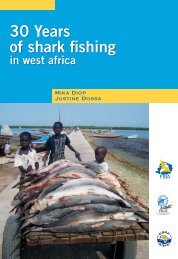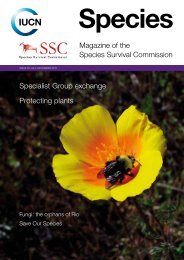Kyne & Simpfendorfer.. - Shark Specialist Group
Kyne & Simpfendorfer.. - Shark Specialist Group
Kyne & Simpfendorfer.. - Shark Specialist Group
You also want an ePaper? Increase the reach of your titles
YUMPU automatically turns print PDFs into web optimized ePapers that Google loves.
The undescribed Andaman Sea endemic Proscyllium sp. A is known only from five<br />
specimens (Compagno et al. 2005).<br />
Family Pseudotriakidae. False Catsharks.<br />
The false catsharks are the only carcharhinoid sharks, and indeed the only non-lamnoid<br />
sharks, to display oophagy (Yano 1992, 1993, Musick and Ellis 2005). Consequently,<br />
fecundity is low. Yano (1993) found the slender smoothhound Gollum attenuatus to generally<br />
possess two embryos, one in each uterus, although a small number of specimens contained<br />
only a single embryo (1.8% of gravid females examined) and two females contained three<br />
embryos (in both cases, one of these had failed to develop). In the false catshark<br />
Pseudotriakis microdon, only litter sizes of two have been observed (Saemundsson 1922,<br />
Taniuchi et al. 1984, Yano 1992, Stewart 2000). The gestation period of both species is<br />
unknown, but for P. microdon at least, it is likely extended, presumably >1 year and possibly<br />
two or three years (Yano unpublished data in <strong>Kyne</strong> et al. 2004). Both sexes of G. attenuatus<br />
mature at ~700mm TL, representing 64%TL max , while maturity in P. microdon is at a very<br />
large size, from 2560mm TL in females, representing 86%TL max (Forster et al. 1970, <strong>Kyne</strong> et<br />
al. 2005).<br />
Family Triakidae. Houndsharks.<br />
The biology of the deepwater houndsharks is poorly-known. There is no information on the<br />
darksnout sicklefin houndshark Hemitriakis abdita beyond that in its original description<br />
(Compagno and Stevens 1993). Triakids are mostly placental viviparous (Musick and Ellis<br />
2005) and litter sizes of 4-5 have been reported for both the longnose houndshark Iago<br />
garricki (Last and Stevens 1994) and the bigeye houndshark I. omanensis (Fishelson and<br />
Baranes 1998). While there is a considerable amount of information on the biology of the<br />
shelf subspecies of the dusky smoothhound Mustelus canis canis, there is little specific to the<br />
island subspecies M. c. insularis which occurs on the outer shelf and slope. The shelf<br />
subspecies has been demonstrated to bear litters of 3–18 pups, reproduce annually with a<br />
gestation period of 11–12 months, reach maturity at 4–7 years for females and 2–3 years for<br />
males, and live to a maximum of 10 years for females and 6 years for males (Conrath and<br />
Musick 2002, Conrath et al. 2002). How these biological parameters relate to the island<br />
subspecies is unknown.<br />
Family Carcharhinidae. Requiem <strong>Shark</strong>s.<br />
Due to its scattered distribution and deep benthic habitat, the only ‘deepwater’ requiem shark,<br />
the bignose shark Carcharhinus altimus, is poorly-known relative to many other species in<br />
the family. It is a diurnal vertical migrator (Anderson and Stevens 1996) and this is discussed<br />
later in this Section (see page 104). Carcharhinids are placental viviparous, with the exception<br />
of the yolk-sac viviparous tiger shark Galeocerdo cuvier (Musick and Ellis 2005). Litter size<br />
in C. altimus is reported at 3–15 and although the gestation period of the species is unknown,<br />
it is usually 9–12 months in requiem sharks, and in this family the reproductive cycle may be<br />
either annual or biennial (Stevens and McLoughlin 1991, Compagno et al. 2005). This is a<br />
large shark, possibly reaching 3000mm TL with size at birth from 600mm TL, female<br />
maturity from 2050mm TL and male maturity from 2040mm TL (Stevens and McLoughlin<br />
1991, Crow et al. 1996, Compagno et al. 2005).<br />
87
















